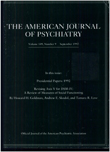Decision making in psychiatric civil commitment: an experimental analysis
Abstract
OBJECTIVE: Legislation in Canada and the United States that was intended to decrease the use of civil commitment has resulted in a paradoxical increase in involuntary hospital admissions. To elucidate the reasons for this increase, this study was designed to assess the relative importance of various factors involved in the decision to commit a patient. METHOD: All psychiatrists in Ontario were sent a questionnaire asking them to make commitment decisions based on hypothetical case vignettes. Four factors were systematically varied in the vignettes: the patients' legal commitability, clinical treatability, alternative resources, and psychotic symptoms. Completed questionnaires, with three vignettes each, were returned by 495 respondents. RESULTS: All four variables were statistically significant in the expected direction; legal commitability (i.e., dangerousness to self and/or others, inability to care for self) and presence of psychotic symptoms accounted for the majority of the variance in the final decision to commit. CONCLUSIONS: These results suggest that psychiatrists in Ontario rely primarily on legally mandated factors (i.e., psychosis and dangerousness) in making their decisions to commit, although a considerable amount of individual variation is also evident.
Access content
To read the fulltext, please use one of the options below to sign in or purchase access.- Personal login
- Institutional Login
- Sign in via OpenAthens
- Register for access
-
Please login/register if you wish to pair your device and check access availability.
Not a subscriber?
PsychiatryOnline subscription options offer access to the DSM-5 library, books, journals, CME, and patient resources. This all-in-one virtual library provides psychiatrists and mental health professionals with key resources for diagnosis, treatment, research, and professional development.
Need more help? PsychiatryOnline Customer Service may be reached by emailing [email protected] or by calling 800-368-5777 (in the U.S.) or 703-907-7322 (outside the U.S.).



